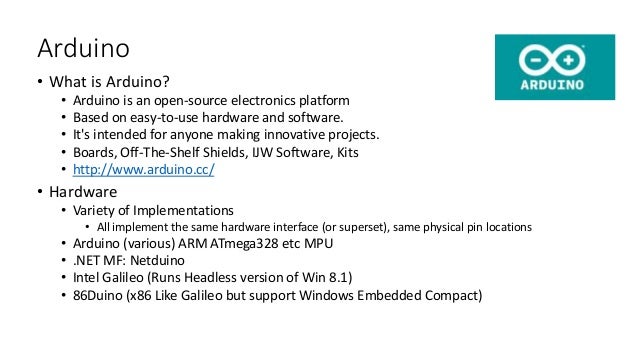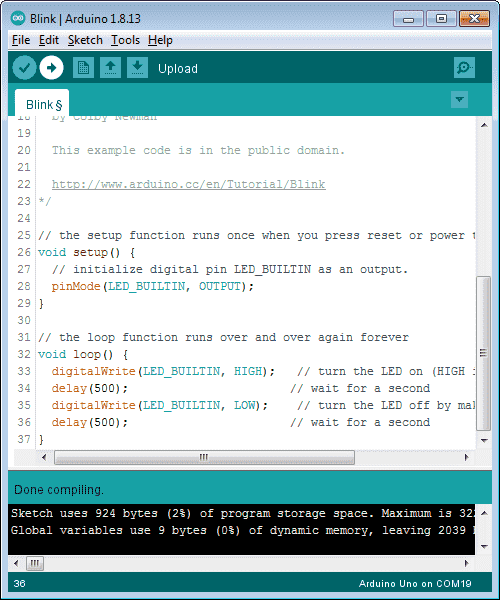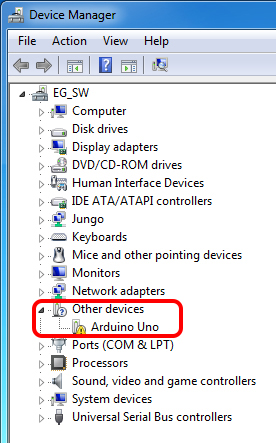Arduino Zero compatible, with narrow (0.3' row spacing) 16-pin DIP footprint (breadboard compatible). It features built-in buck (to power external circuitry) and boost (to power USB devices when operating as a USB host) converters and software selectable output voltage. Nucleo boards: STM8 / STM32 ST.
- I understand how USB works and struggle with writing USB driver code for microcontrollers. Instead invest in a device that already does what you want (such as a Teensy 3.x), or move away from Arduino and use a professional environment with professional tools and examples to work with.
- I installed Arduino IDE from the Windows Store. There were hiccups in USB driver installation under my Windows 10. Solution that I found: Arduino Uno: - Will mostly work out of the box. If not recognized, install the drivers from Microsoft Windows 10 update site.
- When the Arduino Software (IDE) is properly installed you can go back to the Getting Started Home and choose your board from the list on the right of the page. Last revision 2016/08/09 by SM. The text of the Arduino getting started guide is licensed under a Creative Commons Attribution-ShareAlike 3.0 License. Code samples in the guide are.
- The Arduino Nano is a small, complete, and breadboard-friendly board based on the ATmega328 (Arduino Nano 3.x). It has more or less the same functionality of the Arduino Duemilanove, but in a different package. It lacks only a DC power jack, and works with a Mini-B USB cable instead of a standard one.
The first time using a new microcontroller is what I call funstrating, especially if you don’t have clear instructions. We’ve done the hard work of figuring out the NodeMCU drivers and NodeMCU Arduino IDE setup for you. Read on for the two steps that have to be done only once. More helpful info at the end, too.
Installing NodeMCU drivers for USB
This part of the instructions are written for Windows. They’re very similar for OSX and Linux.
Mostly these days devices download and install drivers on their own, automagically. Unfortunately as of writing this post when I plug a brand new NodeMCU into a new Windows 10 installation with a micro USB cable I get a warning message that says “USB Device Not Recognized – Device Descriptor Request Failed”.
Windows doesn’t know how to talk to the USB driver on the NodeMCU so it can’t figure out that the board is a NodeMCU and proceed normally. You’ll need to download the official driver and install it yourself.
The official NodeMCU drivers are here.
Download and extract the files, then run the Windows 10 installer. NodeMCU should now appear as a COM port on your Windows 10 computer.
Please post OSX-specific instructions them in the comments below.

Upgrade Arduino Boards Manager
We’re almost done! This next bit is pretty easy. Arduino has a list of possible microcontrollers (boards) that it can support if you ask it to add support. This does two useful things: it keeps the download smaller for them (less $) and it means new users are not swamped with lots of options they may never use. We need to add NodeMCU to the list of possible microcontrollers and then tell Arduion “Please download and install support for NodeMCU.”
Fire up Arduino IDE and go to File > Preferences.
In the field that says “Additional Boards Manager URLs” add “http://arduino.esp8266.com/stable/package_esp8266com_index.json” and hit OK. Now your Arduino IDE knows that NodeMCU boards exist.
go to Tools > Boards > Boards Manager
There are a lot of boards here! In the search field type “esp8266”, which is the name of the Wifi module at the heart of the NodeMCU.
You can see in my copy I’ve already installed the plugin. Click once anywhere on the description text. A button labelled “install” will appear nearby. The location is inconsistent, and IMHO the button should always be visible if the plugin has not been installed. Click it and the installation process will begin. As of this writing it has to download ~150mb of data. Once it’s done, close the Boards Manager.
To back to Tools > Boards and you will find the list is now quite a bit longer.

Choose your flavor of NodeMCU (probably 1.0 ESP-12E Module) and start coding.
NodeMCU example sketches
Examples for any given board type should appear under File > Examples. Examples are tailored to the type of board that you have currently selected. If you don’t see any NodeMCU or ESP examples, double check that you have Tools > Boards > [your NodeMCU flavor] selected. One time I changed board type to UNO and all my NodeMCU examples vanished. So confusing!
Final thoughts
- Sketch upload time is long compared to UNO or Mega. Still worth it!
- When using digitalWrite(), use digitalWrite(D0) instead of digitalWrite(0) and so on. Pin mapping on the NodeMCU is weird.
- Wifi sketches need the SSID and password of your local Wifi network in order to connect. In the top of most sketches you’ll find a field “….” that should be replaced with your wifi SSID and/or wifi password.
See Also
[products skus=’ELEC-0108, ELEC-0041, ELEC-0111′]
- 4Install the Driver
Download Arduino Environment
You can directly download the latest version from this link: http://arduino.cc/en/Main/Software. When the download is finished, unzip the downloaded file. Be sure to preserve the folder structure. Double-click the folder to open it. There should be several files and sub-folders inside.
The Arduino Software (IDE) allows you to write programs and upload them to your board. In the Arduino Software page you will find two options:
1. If you have a reliable Internet connection, you should use the online IDE (Arduino Web Editor). It will allow you to save your sketches in the cloud, having them available from any device and backed up. You will always have the most up-to-date version of the IDE without the need to install updates or community generated libraries.
2. If you would rather work offline, you should use the latest version of the desktop IDE .
Install the Arduino Desktop IDE
To get step-by-step instructions select one of the following link accordingly to your operating system.
Windows
Mac OS X
Linux
Portable IDE (Windows and Linux)
Choose your board in the list here on the right to learn how to get started with it and how to use it on the Desktop IDE.
Example for Installing Arduino IDE
STEP 1: Go to https://www.arduino.cc/en/Main/Software and find below page on the official website.
The version available at this official website is usually the latest version. So in the following will show you the installation for this version.
In general, we will provide you with the Arduino 1.5.6 version package in our data. And the setup will be the same.
STEP 2:Download the development software that is compatible with the operating system of your computer. In the following, take Windows as an example.
First, Click Windows Installer, you will get the following page.
Then, Click JUST DOWNLOAD. After downloading the software installation package to your PC, start the STEP 3 below.
STEP 3:Installing Arduino Software(Windows)
Install Arduino with the exe. Installation package you have downloaded well.
Get the latest version from the download page. You can choose between the Installer (.exe) and the Zip packages. We suggest you use the first one that installs directly everything you need to use the Arduino Software (IDE), including the drivers. With the Zip package you need to install the drivers manually. The Zip file is also useful if you want to create a portable installation.
Frist,Click “I Agree”.
When the download finishes, proceed with the installation and please allow the driver installation process when you get a warning from the operating system.
Then, click “Next”
Next, click “Install”.
When the following interface appears, click Install to finish the installation.
Finally, click “Close” after completing the installation.
And you will see the following icon appear on the desktop
Install the Driver
Installing Drivers for Arduino Board in Windows 7
Before launch the Arduino software, you are going to install the USB drivers.
Plug one end of your USB cable into the Arduino and the other into a USB socket on your computer.
- First, right click “Computer” —>select “Properties”—> click “Device manager”, you should see an icon for ‘unknown device’ with a little yellow warning triangle next to it. This is your Arduino.
- Right-click on the device and select the top menu option (Update Driver Software...).
- You will then be prompted to either ‘Search Automatically for updated driver software’ or ‘Browse my computer for driver software’.
Arduino Llc (www.arduino.cc) Usb Devices Drivers
In this page, click “Browse my computer for driver software”.

- Select the option to browse and navigate to the drivers folder.
- Click 'Next' and you may get a security warning, if so, allow the software to be installed. Once the software has been installed, you will get a confirmation message.
Arduino Llc (www.arduino.cc) Usb Devices Driver Updater

- Installation completed, click “Close”.
- After installation, go to check the “Device manager” again. right click “Computer” —> “Properties”—> “Device manager”, you can see the device shown as below figure.
Example for Using Arduino IDE
Arduino Llc (www.arduino.cc) Usb Devices Driver Download
When successfully installing the USB driver for UNO R3 board, you can find the corresponding serial port in Windows Device Manager.Next, we will show you the program “Hello World!” displayed on the serial monitor of Arduino IDE. Here we use the Arduino 1.5.6 version.
Sample Code as below:
Copy and paste the following source code to Arduino IDE.
Then,set the Board and COM port, shown below.
Arduino Llc (www.arduino.cc) Usb Devices Driver Windows 7
If setting well the board and port, you can see it display on the bottom right corner, which is the same as the Device Manager display.
Then, click the verify to compile the sketch, if no mistake, click upload to upload the program.
Done uploading, open the serial monitor on the upper right corner and set the baud rate as 9600, enter an “R” and then click “Send”, finally you can see the D13 indicator on the UNO R3 board blinks once, and “Hello World!” is displayed on the serial monitor. Shown below.
Congrats. Your first programming is done well!

Related Data Download
Using Method for keyestudio UNO R3:
You can download the driver installation or software from below link:
https://drive.google.com/open?id=12D-JkXdNm03Qt4dlPQr3RP6OmgXqpvHc
Reference for Arduino Programming Language
Arduino programming language can be divided in three main parts: structure, values (variables and constants), and functions.
You can see more details on the following link:
https://www.arduino.cc/reference/en/